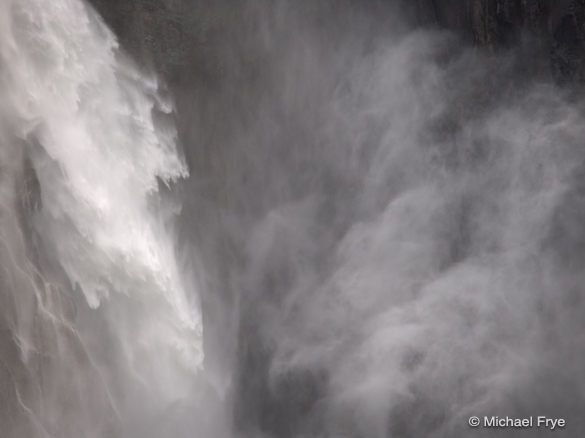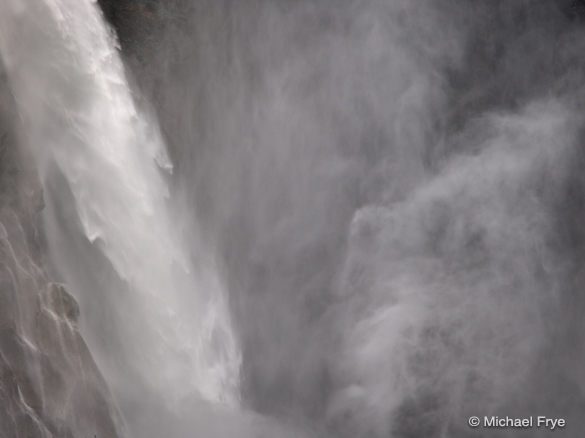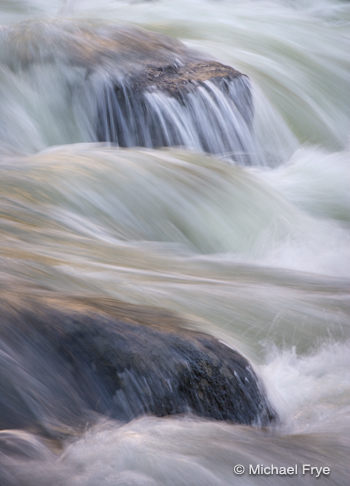Living near Yosemite I often photograph moving water—big, thundering waterfalls, small cascades, and everything in between. If you watched me photographing some of these scenes, you’d see me pressing the shutter over and over again without moving the camera or changing any of the settings—just click, click, click, click, click…
Am I just wasting space on my Compact Flash card? No—there’s a method to this madness. Water moves. A waterfall or river changes from one second to the next. In fact it’s never exactly the same twice. So while my composition, shutter speed, and aperture may be the same, each photograph is different, and some are bound to be better than others.
In the photograph of Cascade Fall at the top I used the exact same composition, shutter speed, and aperture as the one below. But in version 1 the spray on the left and mist on the right are both more interesting. Nothing changed but the moment. I took 38 identical exposures to make sure I got one good one.
Below you’ll find two more examples, this time from Happy Isles. Again, the composition, shutter speed, and aperture were identical in both. But in version 1 the water covers the top of the rocks, hiding the reflections. Version 2 has golden reflections on those boulders, and the fan-like shapes of the water spilling off the rocks are also better. Here I took thirty-one identical frames to get one that really worked.
So when photographing moving water—or any moving subject—don’t be stingy. Take more frames than you think you need—then add twenty more. It’s not like you’re wasting film!
—Michael Frye













Excellent (and many times ignored) topic Mike.
Thanks!!!
I do the same thing. Like your Happy Isles shot, I noticed that minute changes in the flow of water over the rocks can have significant effect on the color – or amount thereof – in a scene.
Sometimes it is the most subtle differences that makes just one frame stand out from all of the rest. Point well made Michael.
Spot on Michael!! I occasionally go up to the North Shore of Oahu to photograph the wave action; when I do, I can easily go through 4 or 5 rolls of Velvia from the same location. Watching the patterns of the wave front is fascinating.
Yes. I do this all the time as well – it’s “stochastic” photography. Sometimes, it’s best to do that anyway because it’s only afterwards that you see what kinds of thing change in a split second.
I did that today, a bright sunny morning, photographing a twig on a dry stone wall. In under 1/4 second, the pattern of dappled light had changed in ways I didn’t expect.
There’s another couple of reasons to do it as well: you can stack (average) two or more frames to double the signal:noise ratio (ie for every time the number of images doubles, the effective ISO halves); also if you’re shooting handheld, you can upscale before you realign and minute camera movements will add image-data into pixels interpolated by the upscaling, so you get super-resolution.
I thought It was just me, good to hear I’m not the only one out there click, click, clicking away at the moving water. Will be sure to show this to my husband who gets impatient with me 🙂
Click click click….now we need a post on how to handle all the terrabytes we have shot. ;-P I find self editing very difficult–and I have so many many images now.
Yes, I do the same thing. Thanks for putting it into words to remind me it’s ok to take tons of photos of the same thing!
Great advice! The second photo set you showcase really shows the value in this method.
I did exactly that when I was in the valley few days back along Bridal Veil creek and along the Misty trail.
Beautiful images as always Michael.
Great write up Michael and great pictures. Thank you!
That makes so much sense. However, I have never even thought of it before. Thank you for sharing that terrific insight on photographing waterfalls. Your images are excellent!
I was just doing something similar at the shores of Lake Michigan! You just can’t predict when the perfect water moment will come. I like the examples you showed, Michael. In each, the composition is fine, but in the ones you really like, you can see the difference a slight change in water movement can make.
Your photo’s are great—no matter how many frames you do—they are awesome!!
Thanks very much for chiming in here everyone. Glad to see this post got such a good response. And it sounds like many of you do the same thing – great!
Robert, in your case you are wasting film! Well, maybe not wasting… using it for a good cause. 🙂
Tim, interesting points about noise reduction with multiple images; I’ll have to try that. At low ISOs there isn’t much noise to begin with, but perhaps it would help with higher ISO images.
Cat, nice – I’m happy to help a fellow photographer with an impatient spouse!
Charlene, you pointed out the obvious problem with this approach, which is sorting out the large number of images you end up with. It can be difficult to decide which is the best one. But once you’ve done that you’re bound to end up with a better image than if you just took one or two. And you can then always delete the others! Also, if you’ve narrowed it down to say, five, and can’t decide among them, then it probably doesn’t matter – they’re probably all equally good.
Great advice and excelent photos.Thanks.
Michael, I appreciate this post on several counts.
First, it helps dispel some (though plenty of others remain!) of the romantic myths about how photographs are made. One that does few people much good suggests that “real photographers” completely pre-visualize the final photograph in all of its details, slowly and methodically consider the subject, perfectly calculate the ideal exposure… and then make a single, perfect, sublime exposure. No poor exposures or safety shots are every made.
As you know, and as virtually everyone who shoots this stuff knows, the truth is much much different. Despite the occasional shot that is done in a manner that approximates the myth, it is not always possible to control or even see in advance the ephemeral and transitory things that make a great photograph. In fact, I’d argue that in at least some cases, it is the skill at understanding, anticipating, and responding intuitively to the transitory subjects that may be one of the most important.
So, any post reminding people that photography is done in a number of different ways is a good one!
This also brings up yet another way that digital capture methods are changing photography. I’ve heard other photographers speak about how the ability to make many “captures” has changed their approach to subjects like moving water, transitory light, clouds and so forth.
I’m sure that you wouldn’t make this error, but some might imagine that the ability to shoot this way – standing there and making 40 exposures of the same subject – means that the photographer doesn’t really need any visualization talent. This is completely untrue. I use this technique, too, and for me at least it requires great focus and very quick responses. For example, this year I have used this to photograph, among other subjects, Cascade Creek. I don’t just point and shoot. I watch the water and rocks and try to understand what it happening – what variations are there in the flow, how often does the water cover or uncover a rock, are there moments when things are more or less still? Then I watch this and try to respond instantaneously to this dynamic scene… a few dozen times.
Take care,
Dan
Thanks Maria – glad you found this helpful.
Dan, thoughtful comments as always! We may partly blame the romantic myth you refer to on Jim Brandenburg, who did that wonderful project where he took exactly one frame per day for 90 days. But that is the rare exception, and even he would tell you that while that was a great personal challenge for him, it’s not the best method in most circumstances.
In your last paragraph you bring up a good point that, in the interest of keeping things simple, I deliberately glossed over in the post – the part about your watching the water and rocks and trying to understand what’s happening, and trying to time your exposures for the best moments. I did that in both the examples here. In other words, I didn’t just fire off 38 and 31 frames, respectively, and hope for the best. I tried to time my exposures for optimal moments, but it still took many frames to get it right. And there’s always the thought, even after you’ve pressed the shutter 30 times, that number 31 could be better!
I’ll add that sometimes I don’t really know what to look for until I’ve taken a few frames. That was the case with the second pair here from Happy Isles, where I didn’t fully realize that the reflection on top of the rocks was appearing and disappearing until I noticed that some of my exposures had that reflection and some didn’t. After noticing this I tried to anticipate moments when the water wouldn’t be covering the top of the rocks. But I also wanted those fan shapes of water coming off the rocks too, and getting both was difficult – which was why it took so many exposures to get what I wanted.
This all makes sense and is again another excellent post that I will apply to my own photography of moving water. It also indirectly pays great tribute to the old large format photographers who made only one exposure and timed their photographs accordingly to get magnificent water images.
Thanks David! There’s no question that digital cameras make moving water photos easier, as you can see what you’re getting, then adjust the shutter speed, or notice things like those reflections I mentioned in my last comment – plus, of course, capture many frames without worrying about the expense. Yet many great moving water photos have been made with film. It does take some skill, but it can be done. I suspect though that even those exposing sheets of expensive large-format transparency film usually take/took more than one frame in these situations.
My problem with that method is that I universally end up with 50 versions my equivalent of what Michael calls Cascade Falls Version 2 above – all nice (for me, not for Michael) but in a
generically irrelevant way. On the other hand, getting Happy Isles, Version 2 requires a bit more
than randomly shooting away, unfortunately. It does not seem like stochastic photography to me
at all. Getting that light right requires all of previsualization needed in other types of photography, except that now you have to try a few times to get what you want since there is some randomness in water flow involved. Michael, could you tell us how many of the shots of Happy Isles were an approximation of Version 2?
Lenya, version 2 of Happy Isles was the best, but there were perhaps three or four others that had the reflections and decent shapes of the water fanning over both boulders. Many had a reflection on one rock and not the other, or good fan shapes on one boulder, but not the other.
Hmmm, interesting post, Michael. Just recently I took some roaring river shots, and did the same thing … and ended up choosing one of some others because I liked the look of how the water splashed in that particular shot.
I’m curious – in addition to taking multiple frames with the same settings, do you do much bracketing? I find shots this time of year (well, this year 🙂 with patches of snow to be a challenge because they get blown out – so either have to bias the exposure & adjust the darker sections in PP, or bracket & do lots of editing with layers. Maybe this could be a topic for an upcoming post? 🙂
Thanks, always, for the informative and though provoking posts.
Hi Michael, I really enjoyed this post. In fact, it gave me some ideas for a new blog post including a recent image of the upper Cascade Falls area plus another take of the same section of the upper falls from 2005. I linked to this page so that my readers could read your comments (see above).
Thanks for sharing your insights,
Bill
Bill (Heiser), thanks – glad you enjoyed the post. The only time I bracket is in high-contrast situations where I think I might need to blend exposures together later. I do the blending with either Photoshop or LR/Enfuse. So I wouldn’t say I do a lot of bracketing, but sometimes it’s very useful.
Bill (Neill) – thanks! Glad you liked this post, and thanks for linking to it from your blog. I just read your post – great stuff, and I really like the new Cascade Creek image. You take even more frames than I do! But that’s what it takes.
Nice article Michael that illustrates an important point, but hopefully won’t lead to people taking a spray-and-pray technique into their other work. I think it’s very important to be able to recognise the key moment and commit to making a photograph of that moment – and not just thinking ‘well it doesn’t cost me anything to make 40 exposures of the same thing!’
I’ve recently made a move back to film, so for me it’s not feasible to make more than a few exposures of any given scene – and none are bracketed. A lot of the time, I only make a single exposure if there’s no water involved.
However, if there is water, I’ll make two or three exposures while paying careful attention to the water’s movement before each exposure. I’ve used similar techniques to photograph fields of crops on a windy day.
Tim
Tim, yes, I hope people won’t think that “spray-and-pray” is the way to go. But I wrote this because I routinely see people in workshops (with digital cameras) take one frame of a water image like this and then move on, thinking they “got it.” But they didn’t.
Certainly digital capture is a big advantage with moving water – not just because you’re not thinking about the expense of each frame, but because you can actually see the effect of the motion. This allows you to fine-tune the shutter speed, but perhaps more importantly, judge whether the composition is working, as it’s often difficult to visualize the effect of the movement on the composition as a whole. This is a big reason why my friend Charlie Cramer (to cite one example) switched from 4×5 film to a Phase One back. Of course this is a rather expensive option… 🙂
I do still use a digital camera for visualisation, so I have some idea of what the final image will look like. I’d love to one day get a Phase back, but like you say it’s not a cheap option and certainly not for the feint of heart. The one thing I do love about film is the fact that by the time I see my images for the first time I’ve lost the emotional attachment to them. OK there are probably more failures than there would be with digital as I’ve got no feedback on exposure, but it’s very easy to self edit when there’s little or no emotional attachment to the images.
I used to struggle immensely with getting home from a day’s shoot and going through the images made. They would all look great when in actual fact a lot of them maybe weren’t and my emotional attachment to those images was unfortunately impeding my ability to take an unbiased look at the images. I don’t lose emotional attachment from the images completely, however – it’s just that the emotion I felt at the time is no longer at the front of my mind so it’s easier to be more brutal in self-editing. I’m not sure if you’ve covered this before on the blog (I seem to remember you did write something along these lines?), but I feel it’s maybe another important skill to learn in the digital age.
All the best,
Tim
Re: Why Am I Taking Forty Frames of the Same Thing?
Thank you for the post Michael.
My friends really get bored when they accompany me on a shoot, because I do the same thing.
I also change lenses, and shoot more clips of the same subject at different focal lengths, to use as transitional clips on a video project.
Animals, water, clouds, and most important … LIGHT is constantly changing.
Sometimes the shot that I thought was “the best”, doesn’t look as appealing when I import it to Final Cut (video) and/or Lightroom (still photos) for editing.
Those extra clips can come in quite handy.
I am heading out for the next two days to shoot some video at St. Marks National Wildlife Refuge, on the Gulf of Mexico.
Have a Happy New Year!
Paolo
Smoky Cat Productions
Nature & Wildlife Videography
Jacksonville, FL
Ah yes, it’s difficult to photograph with friends who aren’t photographers… And you’re right, our judgement of what’s the best photograph in the field often changes when we see the images on a larger screen later.
Hope you have fun at St. Marks!